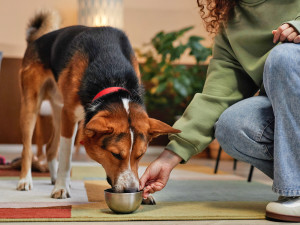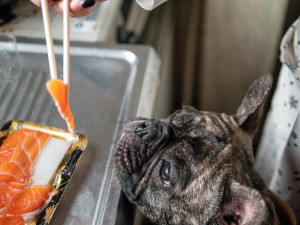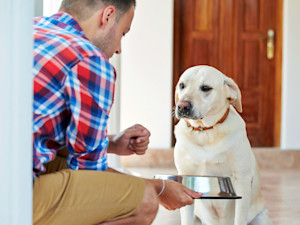When Can Puppies Eat Wet Food?
In This Article:
At What Age Can Puppies Start Eating Wet Food? Is Wet Food Good for Puppies? How to Wean Your Puppy onto Wet Food The Best Wet Foods for Puppies Frequently Asked Questions
Puppies can be introduced to wet food at about four weeks old, when they are typically starting to be weaned off their mother’s milk. Introduce wet food gradually, mixing it with water, milk, or their current food to ease the transition. Ensure the food is specifically formulated for puppies for optimal nutrition.
At what age can puppies start eating wet food?
Puppies can be introduced to wet puppy food when they are about four weeks old. At this age, puppy parents can start the weaning process, which is the transition from milk to solid foods. Around eight weeks of age is when puppies can eat solid food exclusively, but the transition takes some time.
Up until weaning, puppies get all of their nutrition from their mother’s milk, unless they have to be bottle fed due to health or circumstance. Milk or puppy milk replacement formula can provide all the essential nutrients that neonate puppies need to get a healthy start at life. In the first 24 to 48 hours after birth, puppies get colostrum while nursing from their mom. Colostrum is nutrient rich and contains antibodies that provide important temporary immunity early in life.
How much do you spend on your pet per year?
Is wet food good for puppies?
Wet food can provide a healthy puppy diet. Wet or canned food for puppies is a good option for young pups transitioning from milk to solid food. There’s a bit of a learning curve for pups graduating to solid food, and wet food is easier for young puppies to chew and swallow. Wet food makes a great puppy weaning food because it can be softened to almost liquid consistency, and learning to lap up food is easier than jumping straight into chewing pieces of kibble.
When compared to dry kibble, wet food has a much higher water content. This makes it easier to keep pups well hydrated, which can help protect them from issues like urinary tract infections. Wet food also tends to have a stronger aroma and more savory flavor, which can help entice young pups to try something other than Mom’s milk.
How to wean your puppy onto wet food
Weaning doesn’t happen overnight — and it can be a little messy. It typically takes about four weeks for puppies to fully transition to solid food. Puppy parents can start the weaning process when puppies are around four weeks old. The length of the weaning process can vary depending on each puppy’s development and the mother’s temperament.
Introducing soft food
Make a gruel by mixing wet puppy food with warm water or puppy milk replacement formula. If using formula, be sure to use a product that is especially formulated for puppies (cow’s milk and goat’s milk do not provide proper nutrition and can cause stomach upset). The goal is to make the wet food mushy enough for your puppy to easily lap up.
Offer the gruel on a saucer or wide, low-sided bowl that is designed to not tip over. Learning to eat from a dish can be messy. Some puppies will dive in and eat. Some pups may not even try to taste the food the first time they’re offered — they may just dance in it. If this is the case, offer a taste from your finger or place a small amount in their mouth to help them get the hint. If things get a little (or a lot) messy, clean your puppy off so the gruel doesn’t dry on their fur and cause skin irritation.
Transition to solid food
Feed your puppy four meals a day, away from mom. When it’s meal time, offer them wet food or gruel before they have access to nurse from mom. This way, your pup can fill up on wet food before they’re tempted to fill up on Mom’s milk, which should help the weaning process move along.
Gradually add less liquid to the wet puppy food over one to two weeks. By six weeks of age, puppies should be able to handle wet food without any added liquid. By eight or so weeks of age, puppies should be getting all of their nutrition from solid food.
Additional weaning tips
Weaning should help puppies and mom gain independence. Here are some tips to help the process:
Let pups learn from Mom: If puppies are unsure or unwilling to take wet food when first offered, you can get their mom involved in the initial feeding. Puppies can watch Mom lap up some gruel and follow her lead. All other feedings should be separate, though. Although puppies are gaining independence, they should still spend lots of time with their mom during the socialization period when they are learning lots of new things.
Let pups learn from each other: Sharing meal time can promote social learning in puppies. They can learn normal eating behavior and get used to sharing. It can also help reduce the stress of being separated from mom.
Use meal time to schedule potty breaks: Use meal time to aid in potty training. Take puppies outside (or to a puppy pad) to relieve themselves after each meal.
How much wet food to give your puppy
The amount of food a puppy needs depends on the size and weight of the puppy and the feeding instructions of the particular food being fed. Puppy food packaging will usually say how much food is recommended per day by body weight, so puppy parents should divide that amount into the number of meals being offered.
Weaning puppies should be fed four meals a day. Once they are on solid food, they can be fed three or four times a day. Puppies should be meal fed and not free fed. If each meal calls for less than a container of wet food, cover the remainder and store it in the fridge for a later meal.
Be careful not to overfeed. Although young pups are growing fast, they’re still susceptible to overeating and becoming overweight. Chubby puppies may sound cute, but puppy obesity can be detrimental to proper growth, especially in large and giant breed puppies. Puppies should steadily grow and steadily gain weight. If you’re concerned that your puppy is not growing or is losing weight, consult with your veterinarian.
The best wet foods for puppies
If you’re a first-time puppy parent, deciding what to feed a puppy can feel overwhelming with all the options available. Puppies go through rapid bone, brain, and organ development, and they need the nutrients to support their growth. When compared to adult dog food, puppy food is more calorie dense and contains more protein, fat, calcium, phosphorus, and DHA (an omega-3 fatty acid important for brain and vision development).
The best puppy food will have these characteristics:
Meets the correct life stage requirements: It is formulated for puppies and labeled as such. Usually, the label will say the food is formulated for growth.
Is complete and balanced: “Complete” means it has all the nutrients a puppy requires. “Balanced” means it has the correct ratios of these nutrients.
Has an AAFCO nutritional statement: The label clearly states that it meets the nutritional standards set by the Association of American Feed Control Officials (AAFCO). An example may read like this: “Animal feeding tests using AAFCO procedures substantiate that (Brand X Puppy Wet Food) provides complete and balanced nutrition for growth.
Your puppy wants to eat it: Puppies aren’t usually picky, but they shouldn’t need constant encouragement to eat.
You want to buy it: Your puppy’s food shouldn't break your budget. Stick with a high-quality diet that you can afford.
FAQs (People also ask)
What are the best wet foods for puppies?
The best wet food for puppies are ones that are formulated specifically for puppy growth and have an AAFCO statement of nutritional adequacy on the label. The best options are also ones that your puppy will readily eat and that you can afford.
At what age should you start feeding your puppy wet food?
Puppies can be introduced to wet food when they are about four weeks old and ready to start weaning. When introducing wet food to a puppy, mix the food with warm water or puppy milk replacement to make a gruel that’s easy for your puppy to lap up.
What kind of food is healthy for puppies?
Healthy food for puppies will be complete and balanced for a puppy’s rapid growth and development, meaning it will have adequate protein, fat, calcium, phosphorus, omega-3 fatty acids, and other nutrients specific to a puppy’s needs.
References
Neonatal Nutrition: Feeding Puppies and Kittens from Birth to Weaning - 41st Annual OAVT Conference & Trade Show Proceedings













